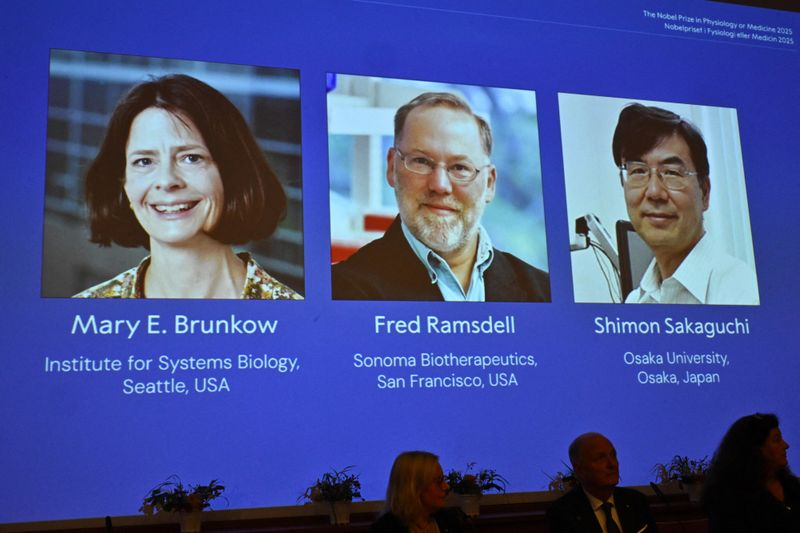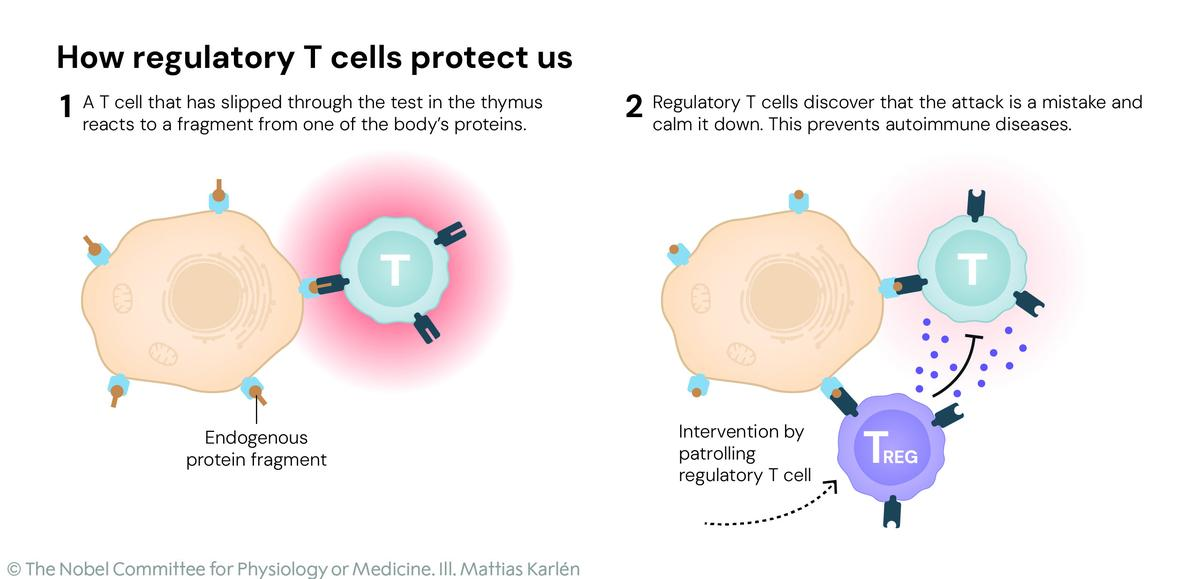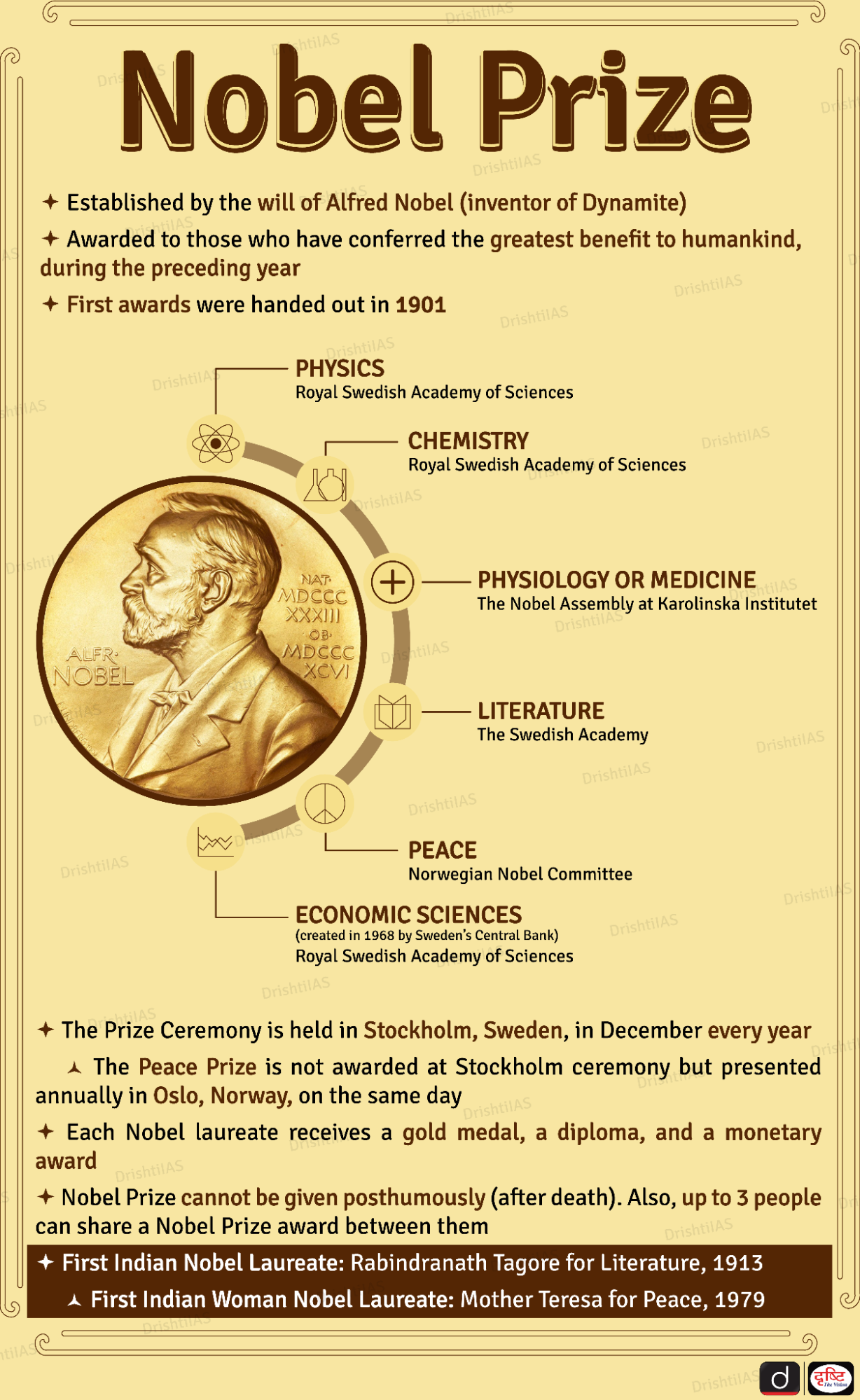Nobel Prize in Physiology or Medicine 2025 | 08 Oct 2025
Why in News?
The Nobel Assembly at Sweden’s Karolinska Institutet has awarded the 2025 Nobel Prize in Physiology or Medicine to Mary E. Brunkow (US), Fred Ramsdell (US), and Shimon Sakaguchi (Japan).
- They were recognized for their discoveries on peripheral immune tolerance, particularly regarding regulatory T cells (Tregs) and the FOXP3 (Forkhead Box Protein P3) gene.
Indian Nobel Laureate in Physiology or Medicine: In 1968, Har Gobind Khorana from India was awarded the Nobel Prize in Physiology or Medicine, along with Marshall Nirenberg and Robert Holley from the US, for their interpretation of the genetic code and its function in protein synthesis.
What are the Key Discoveries of the 2025 Nobel Laureates in Physiology or Medicine?
- Shimon Sakaguchi (Japan): Discovered the existence of regulatory T cells (Tregs) in 1995, showing that some T cells act as “immune system security guards” to prevent autoimmune attacks.
- Mary Brunkow (USA) and Fred Ramsdell (USA): In 2001, identified that mutations in the FOXP3 gene caused a rare autoimmune disease (IPEX) in humans and similar immune dysfunctions in mice.
- Combined Contribution: Sakaguchi later discovered that the FOXP3 gene controls the development of regulatory T cells, explaining how the immune system maintains peripheral tolerance.
Significance of Discoveries
- Cancer therapy: Targeting Tregs around tumors could make immune attacks on cancer cells more effective.
- Autoimmune diseases: Boosting Tregs may prevent the immune system from attacking the body.
- Transplantation: Better regulation of T cells reduces organ rejection.
What are the Key Facts About the Human Immune System?
- About: The immune system is the body's defense mechanism against harmful invaders like pathogens (viruses, bacteria, fungi, parasites), as well as abnormal cells such as cancer cells.
- The immune system can be broadly divided into innate immunity and adaptive immunity.
- Innate Immunity (Non-Specific Defense): It provides a rapid, generalized response against pathogens through physical barriers (skin, mucous membranes), phagocytes (macrophages, neutrophils), and inflammation (helps isolate and destroy pathogens).
- Adaptive Immunity (Specific Defense): It provides a more targeted, specific response to pathogens and has a "memory" that enables the body to respond more efficiently if the same pathogen invades again.
- Key elements include:
- T-cells: Part of the adaptive immune response, T-cells are a type of white blood cell involved in recognizing and destroying infected cells.
- B-cells: These cells produce antibodies (proteins) that specifically target and neutralize foreign antigens (e.g., viruses or bacteria).
- Key elements include:
- Immune Tolerance: The immune system must distinguish harmful invaders from the body’s own cells, maintaining self-tolerance to prevent autoimmune diseases (conditions where the body attacks its own tissues).
- Central Tolerance: This occurs in primary lymphoid organs such as the bone marrow and the thymus, where self-reactive immune cells (cells that could attack the body’s own tissues) are eliminated or rendered inactive.
- Peripheral Tolerance: This involves mechanisms in the body’s tissues that prevent any remaining self-reactive cells from becoming active.
- Regulatory T cells (Tregs) are central to peripheral tolerance, ensuring that the immune system does not attack its own tissues.
- Role of Regulatory T Cells (Tregs): Tregs are a specialized subset of T-cells that act as "peacekeepers" of the immune system that suppress immune responses, helping to maintain immune tolerance.
- They are crucial in preventing autoimmune diseases. These cells help control immune responses to avoid excessive inflammation and tissue damage, and they play a critical role in preventing autoimmune disorders like rheumatoid arthritis, type 1 diabetes, and multiple sclerosis.
Frequently Asked Questions (FAQs)
1. Who won the 2025 Nobel Prize in Physiology or Medicine?
Mary E. Brunkow, Fred Ramsdell, and Shimon Sakaguchi won for discovering regulatory T cells (Tregs) and the FOXP3 gene involved in immune tolerance.
2. What is the role of regulatory T cells (Tregs)?
Tregs act as “peacekeepers” of the immune system, preventing autoimmune reactions by ensuring self-tolerance.
3. What is peripheral immune tolerance?
It is the mechanism by which the immune system prevents self-reactive cells from attacking the body’s own tissues, maintaining immune balance.
4. Who is the only Indian Nobel Laureate in Physiology or Medicine?
Har Gobind Khorana, awarded in 1968 for interpreting the genetic code and its function in protein synthesis.
UPSC Civil Services Examination, Previous Year Questions (PYQs)
Prelims
Q. Nobel Prize winning scientist James D. Watson is known for his work in which area? (2008)
(a) Metallurgy
(b) Meteorology
(c) Environmental protection
(d) Genetics
Ans: (d)



